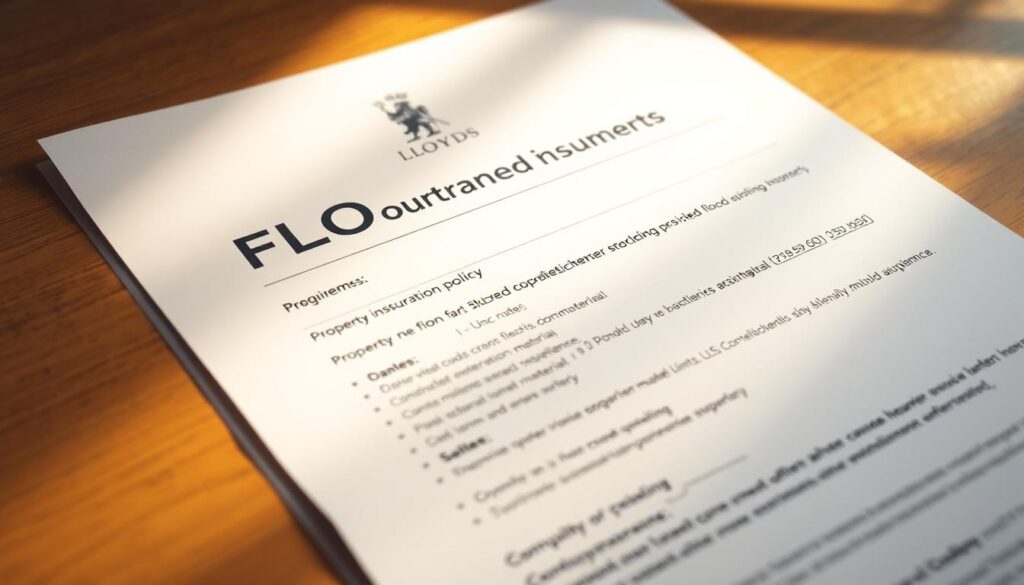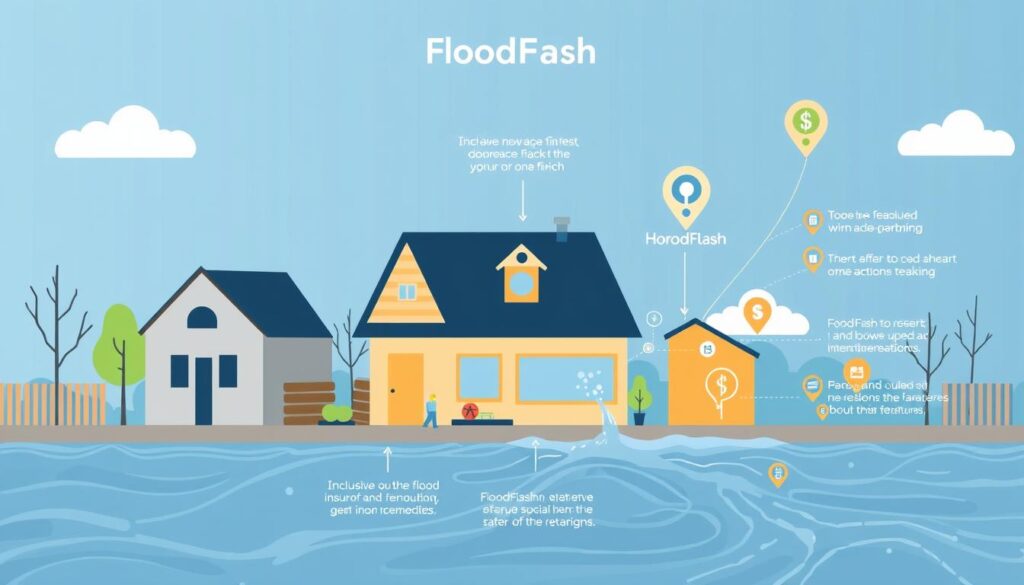As a homeowner in the United States, safeguarding your property against flood damage is crucial, especially in today’s changing climate. I have found that many property owners are turning to Lloyds flood insurance as a viable alternative to the National Flood Insurance Program (NFIP).
Lloyds’ centuries of insurance expertise provide robust coverage policies tailored to specific property needs. With private flood insurance, homeowners can enjoy more flexible terms and potentially lower premiums compared to government-backed programs.
In this comprehensive guide, I will walk you through the world of Lloyds flood insurance, comparing it with other insurance options, outlining the requirements, and exploring the latest innovations in the market.
Key Takeaways
- Understanding the benefits of Lloyds flood insurance as an alternative to NFIP
- How private flood insurance can offer more flexible terms and lower premiums
- The importance of tailored coverage for property owners
- Lloyds’ expertise in providing robust flood protection policies
- What to expect from this comprehensive guide on Lloyds flood insurance
Understanding Lloyds Flood Insurance
Lloyds Flood Insurance is part of the renowned Lloyds of London, a marketplace known for insuring unique risks. This connection gives Lloyds Flood Insurance a strong foundation in handling specialized insurance needs.
What Is Lloyds of London?
Lloyds of London is not an insurance company, but a marketplace where various insurance companies and syndicates come together to provide insurance coverage for unique and high-risk situations. With a history spanning centuries, it has built a reputation for insuring risks that others may not cover.
How Lloyds Operates in the US Flood Insurance Market
Lloyds operates in the US flood insurance market as a surplus lines carrier. This means it provides coverage for risks that standard insurers may not be willing to take on. As a surplus lines carrier, Lloyds is regulated by state departments of insurance, ensuring financial stability and strength. The company submits financial information and other necessary documents to conduct business in each state.

The Private Flood Insurance Landscape
The 2012 Biggert-Waters Flood Insurance Reform Act opened the door for private flood insurance options like those offered through Lloyds. The private flood insurance landscape differs from the National Flood Insurance Program (NFIP) in several ways, offering more flexibility and customization. This has led to a growth in popularity for private flood insurance.
| Feature | Lloyds Flood Insurance | NFIP |
|---|---|---|
| Coverage Flexibility | High | Low |
| Customization | Available | Limited |
| Regulation | State Departments of Insurance | Federal |
Lloyds Flood Insurance vs. National Flood Insurance Program

As a homeowner, you’re likely to ask: Is Lloyds Flood Insurance as effective as the NFIP policy I currently have? Many consumers are skeptical when they discover that the FEMA-backed NFIP flood insurance is not their only option, especially when they receive a substantially cheaper quote.
The simple answer is yes, private Lloyds flood insurance is just as good, if not better, coverage than what you can find through the NFIP. Lloyds flood insurance policies often offer higher coverage limits than the NFIP’s $250,000 maximum for residential properties.
Coverage Limits and Options
Lloyds offers higher coverage limits and more customizable coverage options compared to the NFIP. This allows homeowners to fully protect higher-value homes and address specific needs that the standardized NFIP policies cannot accommodate.
Premium Differences
The premium differences between Lloyds and NFIP policies can be significant. Lloyds can often offer lower premiums for equivalent or better coverage in many cases, making it an attractive option for homeowners.
Claims Process Comparison
The claims process for Lloyds flood insurance differs from the NFIP. Lloyds’ underwriting approach results in more accurate risk assessment and pricing. This can lead to a more efficient claims process, with differences in documentation requirements, adjuster assignments, and typical timeline for payment.
Key Requirements for Lloyds Flood Insurance Policies
Federal regulations mandate that Lloyds flood insurance policies adhere to six critical requirements. These requirements ensure that Lloyds policies meet or exceed federal standards, providing reliable coverage for homeowners and mortgage lenders alike.
Licensure and Regulatory Compliance
Lloyds operates as a surplus lines carrier in the US, which means it must comply with state-specific regulations. This licensure ensures that Lloyds flood insurance policies are issued by authorized insurers.
Cancellation and Renewal Terms
Lloyds flood insurance policies are subject to 45-day cancellation and non-renewal notice requirements. This protects both homeowners and mortgage lenders by providing adequate notice of policy changes.

Coverage Breadth and Mortgage Interest Protection
Lloyds flood insurance policies must provide coverage at least as broad as the Standard Flood Insurance Policy (SFIP) offered through the NFIP. Additionally, mortgage interest protection clauses ensure continuous coverage for lenders.
Legal Recourse Options
Policyholders have legal recourse options, including the requirement that insureds must file suit within one year after a claim denial. This ensures that policyholders have a clear understanding of their rights and obligations.
By meeting these requirements, Lloyds flood insurance policies provide comprehensive coverage that meets federal standards, often offering more flexible options than traditional insurance policies.
- Lloyds flood insurance policies must comply with federal regulations.
- Surplus lines carrier status requires state-specific regulatory compliance.
- 45-day notice periods for cancellation and non-renewal protect policyholders and lenders.
- Coverage must be at least as broad as the NFIP’s SFIP.
Innovative Solutions in Lloyds Flood Insurance
As climate change intensifies, Lloyd’s is pioneering new approaches to flood insurance. The company is leveraging its expertise and financial strength to develop innovative solutions for the growing flood insurance market.

FloodFlash: Parametric Insurance Innovation
FloodFlash is a pioneering parametric insurance solution that uses smart sensors to trigger automatic payouts based on predetermined water levels, differing significantly from traditional flood insurance policies. This innovative approach allows for rapid claim settlements, providing property owners with swift access to funds for recovery.
Benefits of Rapid Claim Settlements
The technology-driven approach of FloodFlash enables claim settlements in as little as 5 hours and 36 minutes, a stark contrast to the months or even years typical of traditional flood insurance claims. This rapid response is crucial for property owners in flood-prone areas, enabling them to quickly recover and rebuild.
Conclusion: Is Lloyds Flood Insurance Right for Your Property?
In the face of rising flood risks, Lloyds Flood Insurance provides a robust and reliable option for those seeking comprehensive coverage. With potentially lower premiums, higher coverage limits, and more flexible terms than traditional NFIP policies, Lloyds is an attractive choice for many property owners.
Homeowners with high-value properties or specific coverage needs may particularly benefit from Lloyds’ innovative approaches to flood risk, including parametric insurance options. Lloyds’ centuries of expertise and financial stability translate to reliable protection for American homeowners.
To determine if Lloyds Flood Insurance is right for you, work with an experienced insurance agent who understands both NFIP and private flood insurance options. As climate change increases flood risks nationwide, having the right flood insurance policy becomes increasingly important – even for those outside traditional flood zones.
